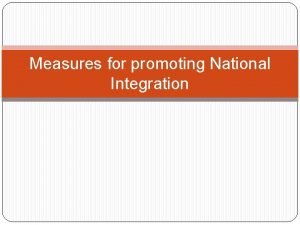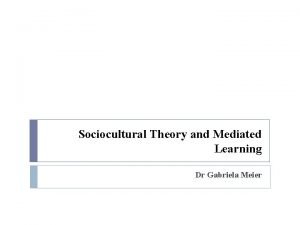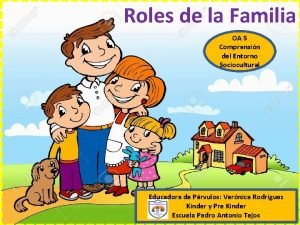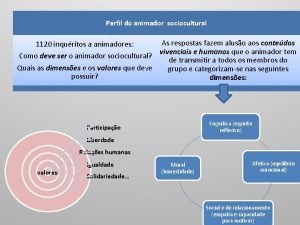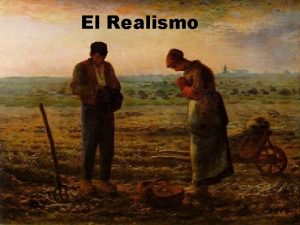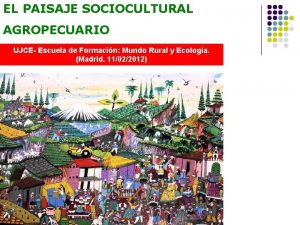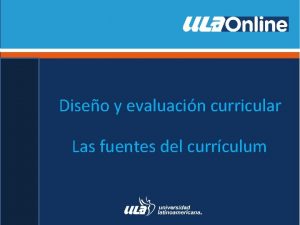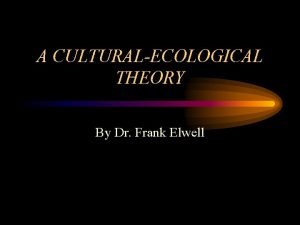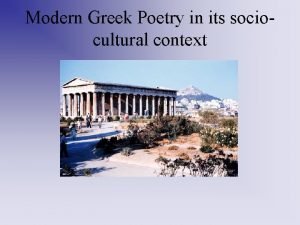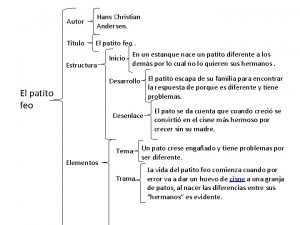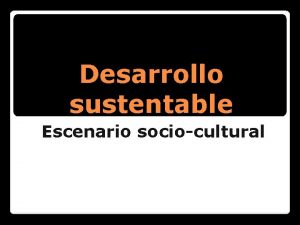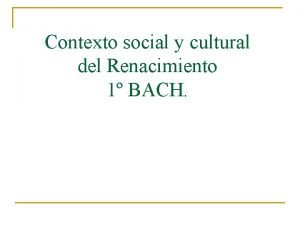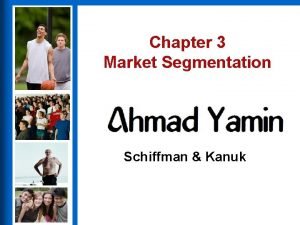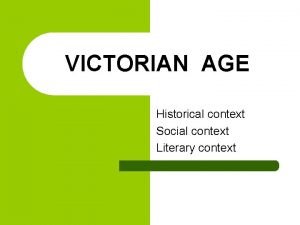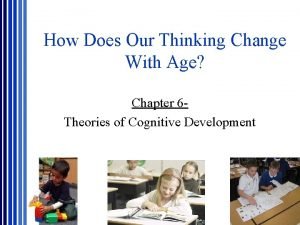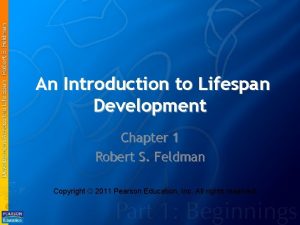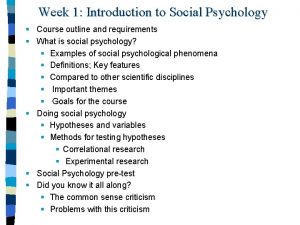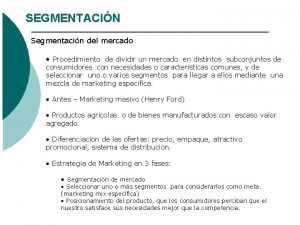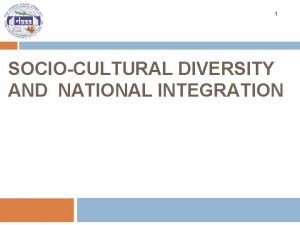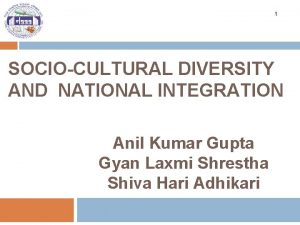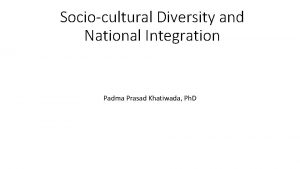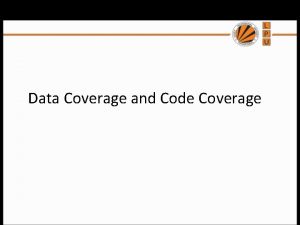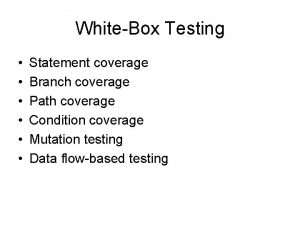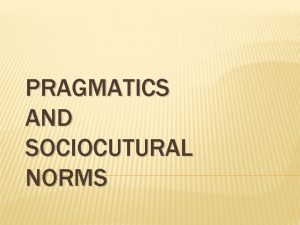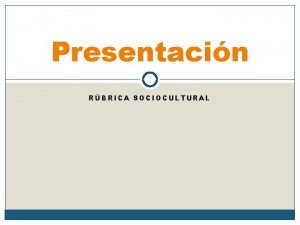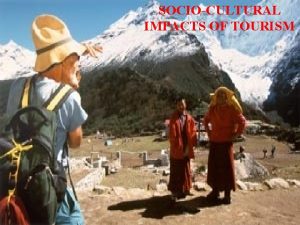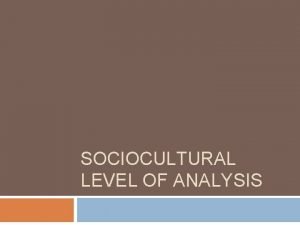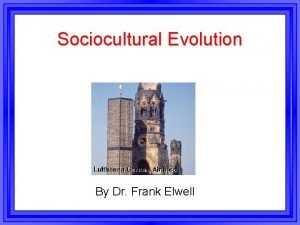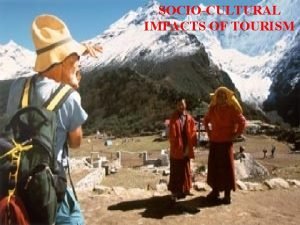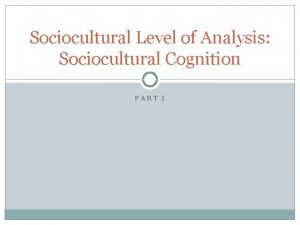SOCIOCULTURAL DIVERSITY AND NATIONAL INTEGRATION Coverage 2 Social

































- Slides: 33

SOCIO-CULTURAL DIVERSITY AND NATIONAL INTEGRATION

Coverage 2 Social structure and social systems Socio-cultural diversity profile Diversity as an asset Diversity dynamism Diversity management and national integration Nation, nationality and social bond

Social Structure and Social Systems 3 What is structure? What is system?

Social Structure and Social Systems 4 Social structure refers to: A) statuses and roles B) a value C) the way the units of a group or society relate to one another

Social Structure and Social Systems 5 Which of the following is a unit of the social structure? A) a status B) group, institution, association and organization C) all of the above

Social Structure and Social Systems 6 An organization means A) co-ordination of social relationships B) co-ordination of parts C) certain positions

Social Structure and Social Systems 7 State whether the following statements are true or false: A) A social system is an orderly and systematic arrangement of social interaction B) Social system has no subsystem

Social Structure and Social Systems 8 State whether the following statements are true or false: A) Social system is not based on interaction of plurality B) Social system is unrelated to cultural system C) There is a functional relationship between the parts of a social system

9

10 Socio-Cultural Diversity Profile

11 Close your eyes Imagine that everyone in the room is same �Same hair �Same height �Same weight �Same gender Everyone dresses the same and sounds the same Now open your eyes, look around. What do you see?

Sex Composition 12 Sex Ratio of Nepal 105 106 104 101. 4 102 99. 5 100 98 96. 8 99. 8 97. 3 96 94. 2 94 92 90 88 1952/54 1961 1971 Sources: CBS, 2001 and 2011 1981 1991 2001 2011

Age Composition 13 1991 54. 15 51. 8 42. 2 2001 2011 57 39. 35 34. 9 5. 8 below 15 year 15 -59 year Sources: CBS, 2001 and 2011 6. 5 60+ year 8. 1

Urban/Rural Population 14 Census Year 1961 1971 1981 1991 2001 2011 Urban Centers Urban Pop (%) Rural Pop (%) 3. 6 96. 4 16 4. 0 96 16 6. 4 93. 6 23 33 9. 2 90. 8 13. 9 86. 1 58 17. 1 82. 9 58 Sources: CBS, 2001 and 2011 Metropolitan City = 6 Sub- metropolitan City = 11 Municipality = 276 Rural Municipality = 460 Source: MOFALD, 2017 (www. http: //103. 69. 124. 141/).

Ethnic/Caste Composition 15 Ethnic /Caste Groups 1991 (%) 2001(%) 2011 (%) 16. 05 15. 8 16. 6 Hill Brahmin 13 12. 7 12. 2 Magar 7. 2 7. 1 Tharu 6. 5 6. 8 6. 6 Tamang 5. 8 5. 6 5. 8 Newar 5. 6 5 Kami 5. 2 4 4. 8 Yadav 4. 1 4 4 Musalman Rai Kiranti 3. 5 3 4. 3 2. 8 4. 4 2. 3 Chhetri Sources: CBS, 2001 and 2011

Religion Composition 16 Religion 1991 2001 2011 Hindu 86. 51 80. 62 81. 3 Buddhist 7. 78 10. 74 9 Islam 3. 53 4. 2 4. 4 Kirat 1. 72 3. 6 3. 1 Christian 0. 17 0. 45 1. 4 Sources: CBS, 2001 and 2011

Language Composition 17 Language 1991 2001 2011 Nepali 50. 31 48. 61 44. 6 Maithali 11. 85 12. 30 11. 7 Bhojpuri 7. 46 7. 53 5. 9 Tharu 5. 37 5. 86 5. 77 Tamang 4. 89 5. 11 Newar 3. 73 3. 63 3. 2 Bajjika - 1. 05 2. 99 Urdhu 1. 09 0. 77 2. 61 Doteli - - 2. 97 Sources: CBS, 2001 and 2011

Education Composition 18 Population aged 6 years and above Sex 1991 (%) 2001(%) 2011 (%) Male 54. 5 65. 5 75. 2 Female 25. 0 42. 8 57. 4 Total 39. 6 54. 1 66. 0 Locations Male (%) Female (%) Total (%) Maximum (Kathmandu) 92 80 86 Minimum (Rautahat) 51 32 42 Sources: CBS, 2001 and 2011

Different Schools of Thought 19 Diversity as a problem Diversity as an asset Exercise �Work in group/pair �You will get 7 minutes �Present in plenary

Diversity Dynamism 20 Game: D & D

Diversity Management and National Integration 21 Exclusion: an obstacle to open and healthy communication between different ethnic, linguistic, religious, and cultural group Is inclusion the ending of exclusion, or much more than that. Assimilation/Integration Exclusionary inclusion, assimilationist inclusion and multicultural inclusion

22 Diversity Management and National Integration Representation and participation Improving social and economic life of people in social and political system Equitable society where economic equality, prosperity, and social justice prevail Recognition of diverse cultures and group identities Integration by changing the existing

23 Nation, Nationality and Social Bond Dividers Vs Connectors

24 Nation, Nationality and Social Bond System and Institutions Vs System and Institutions

25 Nation, Nationality and Social Bond Attitudes and Actions Vs Attitudes and Action

26 Nation, Nationality and Social Bond Different Values and Interests Vs Shared Values and Interests

27 Nation, Nationality and Social Bond Different Experiences Vs Common Experience

28 Nation, Nationality and Social Bond Symbols and Occasions Vs Symbols and Occasions

29 Nation, Nationality and Social Bond Political Econo mic Psychologic al Social

Issues in National Integration 30 Under-representation Discrimination on different ground Illiteracy Regional disparities/uneven development process Social inequalities Regionalism International domination and ideology

Factors Promoting National Integration “united we stand but divided we fall" 31 Constitutional provisions Governmental initiatives Democracy Nation, nationality and binding factors � Strengthening state-people interface � Strengthening multiculturalism � Reducing inequality – vertical and horizontal � Promoting balanced development � Respecting social and cultural diversity

32

33 Thank you
 Why is genetic diversity important
Why is genetic diversity important Ecosystem jigsaw activity
Ecosystem jigsaw activity Forward integration and backward integration
Forward integration and backward integration Make or buy continuum
Make or buy continuum Simultaneous integration and sequential integration
Simultaneous integration and sequential integration Need of national integration
Need of national integration Apa itu social thinking
Apa itu social thinking Social thinking social influence social relations
Social thinking social influence social relations Dr gabriela meier
Dr gabriela meier 5 sociocultural context
5 sociocultural context Segmentacion vals
Segmentacion vals Comprensión del entorno sociocultural
Comprensión del entorno sociocultural Pestel sociocultural
Pestel sociocultural Perfil animador sociocultural
Perfil animador sociocultural Cultural materialism anthropology
Cultural materialism anthropology Realismo características
Realismo características Romanticismo primera mitad del siglo xix
Romanticismo primera mitad del siglo xix Cuál es el contexto histórico
Cuál es el contexto histórico Paisaje sociocultural
Paisaje sociocultural Fuente institucional del curriculum
Fuente institucional del curriculum Barbara rogoff sociocultural theory
Barbara rogoff sociocultural theory Sociocultural system
Sociocultural system Sociocultural
Sociocultural Estructura
Estructura Escenario sociocultural desarrollo sustentable
Escenario sociocultural desarrollo sustentable Contexto social de el lazarillo de tormes
Contexto social de el lazarillo de tormes Sociocultural segmentation
Sociocultural segmentation What is literary context
What is literary context Little emphasis on sociocultural context
Little emphasis on sociocultural context Sociocultural graded influences
Sociocultural graded influences Sociocultural psychology examples
Sociocultural psychology examples Deprivacion sociocultural
Deprivacion sociocultural Socio-cultural analysis
Socio-cultural analysis Vals segmentacion
Vals segmentacion





